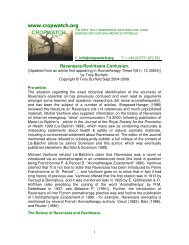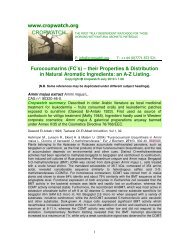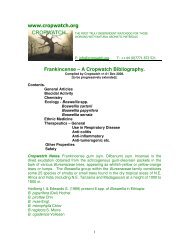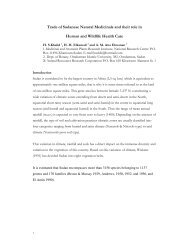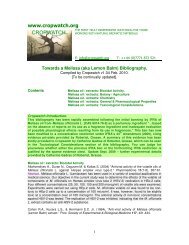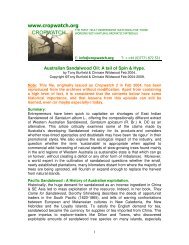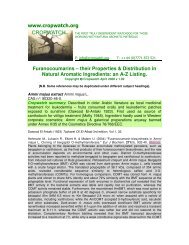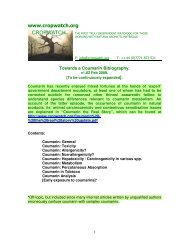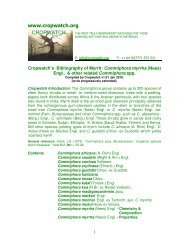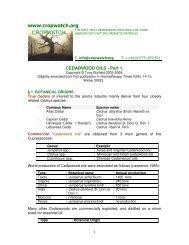Sandalwood Biblio - Cropwatch
Sandalwood Biblio - Cropwatch
Sandalwood Biblio - Cropwatch
Create successful ePaper yourself
Turn your PDF publications into a flip-book with our unique Google optimized e-Paper software.
santalol, a prime determinant of sandalwood oil quality. The study revealed that populations<br />
supporting O. lanceolata in Tanzania occur mostly in arid to semiarid areas with the majority<br />
being on stony and rocky soils. However, big sized trees are supported in humid climates, being<br />
favoured by relatively low soil pH and reasonable amounts of soil nitrogen. Tree density ranged<br />
from 38 individuals to 76 per hectare. The mean tree height was 3, 8 m (2, 1 to 6, 5 m) while the<br />
mean diameter was 5, 7 cm (3, 6 cm to 8, 6 cm). The best quality and quantity of oil came from<br />
populations of relatively arid climates compared to those of humid climates. Populations differed<br />
significantly in both yield and quality. The highest yield obtained was 8, 45 ± 0, 54% from Gubali<br />
population while the highest santalol content (32, 2 ± 1, 2%) was from Bereko populations. Within<br />
trees, quantity and quality of oil was higher in wood portions close to the ground in both the root<br />
and shoot system. The amount decreased toward the root and shoot tip. The root and the shoot<br />
system were similar in quality and quantity of oil. The observed harvesting selectivity is thus<br />
primarily influenced by quality differences among populations while the large dimension and<br />
density differences among populations seem to be secondary. Inclusion of the root systems<br />
during harvesting is also a matter of maximizing the raw material to be collected rather than<br />
differences between the two portions. The exact factors controlling wood quality in the species<br />
have however remained uncertain. Probably, genetic factors alone or in combination with the<br />
environmental factors play a significant role.<br />
Mwang’ingo P.L., Teklehaimanot Z., Hall J.B, Zilihona J.E. (2007) "Sex distribution, reproductive<br />
biology and regeneration In the dioecious species Osyris lanceolata (African <strong>Sandalwood</strong>) In<br />
Tanzania." Tanzania Journal of Forestry and Nature Conservation 76, 118-133. Abstract. Sex<br />
distribution, reproductive biology and regeneration of African <strong>Sandalwood</strong> (Osyris lanceolata)<br />
were assessed in six natural populations of Tanzania between January 1999 and February 2001.<br />
The aim was to acquire basic information required for efficient management, conservation and<br />
sustainable utilization of the species. The study had four objectives: to assess the spatial<br />
distribution of male and female trees in O. lanceolata supporting stands and whether this has any<br />
significance in influencing the reproductive success; to document the phenological events<br />
occurring between flower initiation and fruit ripening; to examine the reproductive success of<br />
various stages through pollination experiment; and to assess the regeneration mode and potential<br />
of the species. The study revealed that, the distribution of male and female trees in most<br />
populations was random with no evidence of sex clustering. It takes 104 days from flowering until<br />
when 25% of fruit initiated become ripe. About 75% of the initiated fruits become ripe in 163 days.<br />
This study has also demonstrated absence of agamospermy behaviour in O. lanceolata. A limited<br />
reproductive success was noted however, due to either low level of pollen production or limited<br />
pollinators' movement. Assisted pollination significantly increased the reproductive success of the<br />
species. The tree regenerates through seeds, rootstocks and coppice. Of the total regenerating<br />
plants assessed at sapling stage, 61% had originated from rootstock or coppice while 39% came<br />
from seed source. It is concluded that, recruitment of the species relies mainly on rootstock or<br />
coppice source although the importance of seeds cannot be ignored. Thus uprooting of the<br />
species as a mode of harvesting has to be discouraged since the practice is likely to severely limit<br />
the recruitment rate.<br />
Mwang’ingo P.L, Teklehaimanot Z., Maliondo S.M. & Msanga H.P. (2004). "Storage and presowing<br />
treatment of recalcitrant seeds of Africa <strong>Sandalwood</strong> (Osyris lanceolata)." Seed Science<br />
and Technology, 32, 547-560. Abstract. The best seed conditions and environment in which<br />
seeds of Osyris lanceolata could be stored to prolong their life span were investigated at Iringa<br />
Tree Seed Centre, Tanzania, by varying the storage moisture content of seeds and storage<br />
temperatures. The study also investigated the effectiveness of various seed pre-sowing<br />
treatments in enhancing germination and early seedling growth. Seeds stored at 3-5°C, after<br />
being dried to moisture content of 20% retained viability longer than those stored at other<br />
conditions. By the end of the 36th week, the viability was 60% with 0.5% being as an estimated<br />
rate of viability loss per week. Temperatures below 3°C and over 13°C decreased rapidly the life<br />
span of seeds. Moisture content below 15% and over 25% were also noted to be lethal. Thus<br />
seeds of O. lanceolata could be stored at least for short-term supply, although their life span<br />
generally remains short, suggesting the need for further research to find out other better storage<br />
24





